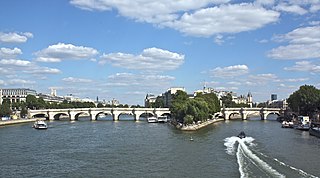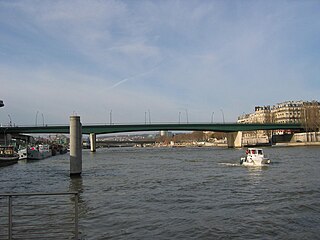
The Pont Neuf is the oldest standing bridge across the river Seine in Paris, France. It stands by the western (downstream) point of the Île de la Cité, the island in the middle of the river that was, between 250 and 225 BC, the birthplace of Paris, then known as Lutetia and, during the medieval period, the heart of the city.

Eugène Freyssinet was a French structural and civil engineer. He was the major pioneer of prestressed concrete.

The Pont Saint-Bénézet, also known as the Pont d'Avignon, was a medieval bridge across the Rhône in the town of Avignon, in southern France. Only four arches survive.

Claude-Louis Navier was a French mechanical engineer, affiliated with the French government, and a physicist who specialized in continuum mechanics.

The Pont Alexandre III is a deck arch bridge that spans the Seine in Paris. It connects the Champs-Élysées quarter with those of the Invalides and Eiffel Tower. The bridge is widely regarded as the most ornate, extravagant bridge in the city. It has been classified as a French monument historique since 1975.

The Pont de Bir-Hakeim, formerly the Pont de Passy, is an arch bridge that crosses the Seine in Paris. It connects the 15th and 16th arrondissement, passing through the Île aux Cygnes. The bridge, made of steel, was constructed between 1903 and 1905, in replacement of a footbridge that had been erected in 1878. The bridge has two levels: one for motor vehicles and pedestrians, the other being a viaduct built above the first one, through which passes Line 6 of the Paris Métro. The bridge is 237 metres (777 ft) long and 24.7 metres (81 ft) wide. The part crossing the Grand Bras of the Seine is slightly longer than the one crossing the Petit Bras.

The Pont de Sully is a bridge across the Seine in Paris, France.

The Pont de l'Alma is a road bridge in Paris, France, across the Seine. It was named to commemorate the Battle of Alma during the Crimean War, in which the Ottoman-Franco-British alliance achieved victory over the Russian army in 1854. The bridge is also known for being the site of the car crash that caused the death of Diana, Princess of Wales, in 1997.

The Pont du Carrousel is a bridge in Paris, which spans the River Seine between the Quai des Tuileries and the Quai Voltaire.
Pont d'Iéna is a bridge spanning the River Seine in Paris. It links the Eiffel Tower on the Left Bank to the district of Trocadéro on the Right Bank.

The Pont Royal is a bridge crossing the river Seine in Paris. It is the third oldest bridge in Paris, after the Pont Neuf and the Pont Marie.

The Pont de l'Archevêché is a bridge crossing the Seine river in Paris, France.

The Pont Marie is a bridge which crosses the Seine in Paris, France.

The Pont d'Arcole is a bridge in Paris over the River Seine. It is served by the Metro station Hôtel de Ville.

The passerelle Léopold-Sédar-Senghor, formerly known as passerelle Solférino, is a footbridge over the River Seine in the 7th arrondissement of Paris. It is served by the Metro station Assemblée Nationale.

Jean-Rodolphe Perronet was a French architect and structural engineer, known for his many stone arch bridges. His best known work is the Pont de la Concorde (1787).

The Pont Louis-Philippe is a bridge across the River Seine in Paris. It is located in the 4th arrondissement, and it links the Quai de Bourbon on the Île Saint-Louis with the Saint-Gervais neighborhood on the right bank.

The Pont du Garigliano is a bridge across the Seine in Paris.
Émiland Marie Gauthey was a French mathematician, civil engineer and architect. As an engineer for the Estates of Burgundy, he was the creator of a great deal of the region's civil infrastructure, such as the Canal du Centre between Digoin and Chalon-sur-Saône (1784–1793), bridges including those at Navilly (1782–1790) and Gueugnon (1784–1787), and buildings such as the Eglise Saint-Pierre-et-Saint-Paul at Givry and the theatre at Chalon-sur-Saône.

The Zouave is an 1856 stone statue by French artist Georges Diebolt, which has been sited on the Pont de l'Alma in Paris since the 1850s. The statue is used as an informal flood marker for the level of the River Seine in Paris.






















